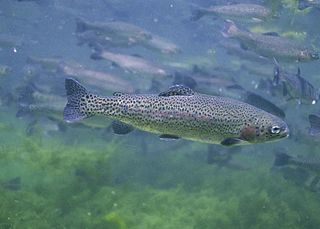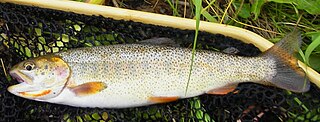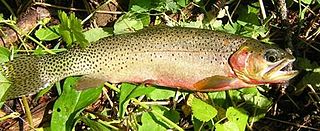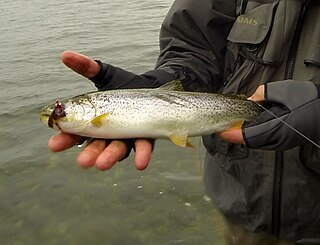
The Teton River is a 64-mile-long (103 km) tributary of the Henrys Fork of the Snake River in southeastern Idaho in the United States. It drains through the Teton Valley along the west side of the Teton Range along the Idaho-Wyoming border at the eastern end of the Snake River Plain. Its location along the western flank of the Tetons provides the river with more rainfall than many other rivers of the region.

The rainbow trout is a species of trout native to cold-water tributaries of the Pacific Ocean in Asia and North America. The steelhead is an anadromous (sea-run) form of the coastal rainbow trout(O. m. irideus) or Columbia River redband trout (O. m. gairdneri) that usually returns to freshwater to spawn after living two to three years in the ocean. Freshwater forms that have been introduced into the Great Lakes and migrate into tributaries to spawn are also called steelhead.

The cutthroat trout(Oncorhynchus clarkii) is a fish species of the family Salmonidae native to cold-water tributaries of the Pacific Ocean, Rocky Mountains, and Great Basin in North America. As a member of the genus Oncorhynchus, it is one of the Pacific trout, a group that includes the widely distributed rainbow trout. Cutthroat trout are popular gamefish, especially among anglers who enjoy fly fishing. The common name "cutthroat" refers to the distinctive red coloration on the underside of the lower jaw. The specific name clarkii was given to honor explorer William Clark, coleader of the Lewis and Clark Expedition.

The Californiagolden trout (Oncorhynchus aguabonita or Oncorhynchus mykiss aguabonita), is a species of trout native to California. The golden trout is normally found in the Golden Trout Creek, Volcano Creek, and the South Fork Kern River. The Golden trout is the official freshwater state fish of California since 1947.

The Bonneville cutthroat trout is a subspecies of cutthroat trout native to tributaries of the Great Salt Lake and Sevier Lake. Most of the fish's current and historic range is in Utah, but they are also found in Idaho, Wyoming, and Nevada. This is one of 14 or so recognized subspecies of cutthroat trout native to the western United States.

The yellowfin cutthroat trout is an extinct subspecies or variety of the cutthroat trout, a North American freshwater fish.

Lahontan cutthroat trout is the largest subspecies of cutthroat trout, and the state fish of Nevada. It is one of three subspecies of cutthroat trout that are listed as federally threatened.

The Colorado River cutthroat trout is a subspecies of cutthroat trout native only to the Green and Colorado River basins, which are west of the Continental Divide. Cutthroat trout found in other river basins belong to other subspecies.

The greenback cutthroat trout is the easternmost subspecies of cutthroat trout. The greenback cutthroat, once widespread in the Arkansas and South Platte River drainages of Eastern Colorado and Southeast Wyoming, today occupies less than 1% of its historical range. It is currently listed as threatened under the Endangered Species Act. It was adopted as the state fish of Colorado on March 15, 1994, replacing the unofficial rainbow trout.

The Snake River fine-spotted cutthroat trout is a form of the cutthroat trout that is considered either as a separate subspecies O. c. behnkei, or as a variety of the Yellowstone cutthroat trout. The fish takes its common name from its original habitat, the Snake River of southern Idaho and western Wyoming, and from its unusual pattern of hundreds of small spots that cover most of its body, differing from the larger-spotted Yellowstone cutthroat pattern. Genetically, it cannot be distinguished from the Yellowstone cutthroat trout, and before the construction of dams, no physical barriers were between the ranges of the two subspecies in the Snake River drainage.

The westslope cutthroat trout, also known as the black-spotted trout, common cutthroat trout and red-throated trout is a subspecies of the cutthroat trout and is a freshwater fish in the salmon family of order Salmoniformes. The cutthroat is the Montana state fish. This subspecies is a species of concern in its Montana and British Columbia ranges and is considered threatened in its native range in Alberta.

The coastal cutthroat trout, also known as the sea-run cutthroat trout, blue-back trout or harvest trout, is one of the several subspecies of cutthroat trout found in Western North America. The coastal cutthroat trout occurs in four distinct forms. A semi-anadromous or sea-run form is the most well known. Freshwater forms occur in both large and small rivers and streams and lake environments. The native range of the coastal cutthroat trout extends south from the southern coastline of the Kenai Peninsula in Alaska to the Eel River in Northern California. Coastal cutthroat trout are resident in tributary streams and rivers of the Pacific basin and are rarely found more than 100 miles (160 km) from the ocean.

A game fish is any species of fish pursued for sport by recreationalists (anglers). The capture of game fish is usually tightly regulated. In comparison, nongame fish are all fish not considered game fish. Game fish may be eaten after being caught, though increasingly anglers are practicing catch-and-release tactics to improve fish populations.

The Crescenti cutthroat trout or the Lake Crescent cutthroat trout is a North American freshwater fish, a local form of the coastal cutthroat trout isolated in Lake Crescent in Washington. While previously attributed to a distinct subspecies Oncorhynchus clarkii crescenti, it is not currently recognized at the subspecies rank. However the cutthroat trout of Lake Crescent do remain distinct. They have the highest known gill raker and vertebrae counts of any coastal cutthroat population. The cutthroat are believed to have been isolated in Lake Crescent after a landslide blocked the eastern outflow of the lake.

Paiute cutthroat trout is one of fourteen subspecies of cutthroat trout. Paiute Cutthroat are native only to Silver King Creek, a headwater tributary of the Carson River in the Sierra Nevada, in California. This subspecies is named after the indigenous Northern Paiute peoples.

The Gibbon River flows east of the Continental Divide in Yellowstone National Park, in northwestern Wyoming, the Northwestern United States. Along with the Firehole River, it is a major tributary of the Madison River, which itself is a tributary of the Missouri River.

Shoshone Lake is a U.S. backcountry lake with an area of 8,050 acres with an elevation of 7,795 feet (2,376 m) in the southwest section of Yellowstone National Park, Wyoming. It lies at the headwaters of the Lewis River, a tributary of the Snake River. The U.S. Fish and Wildlife Service believes that Shoshone Lake is the largest backcountry lake in the lower 48 states that cannot be reached by a road. The Yellowstone Caldera is located within the lake.




















